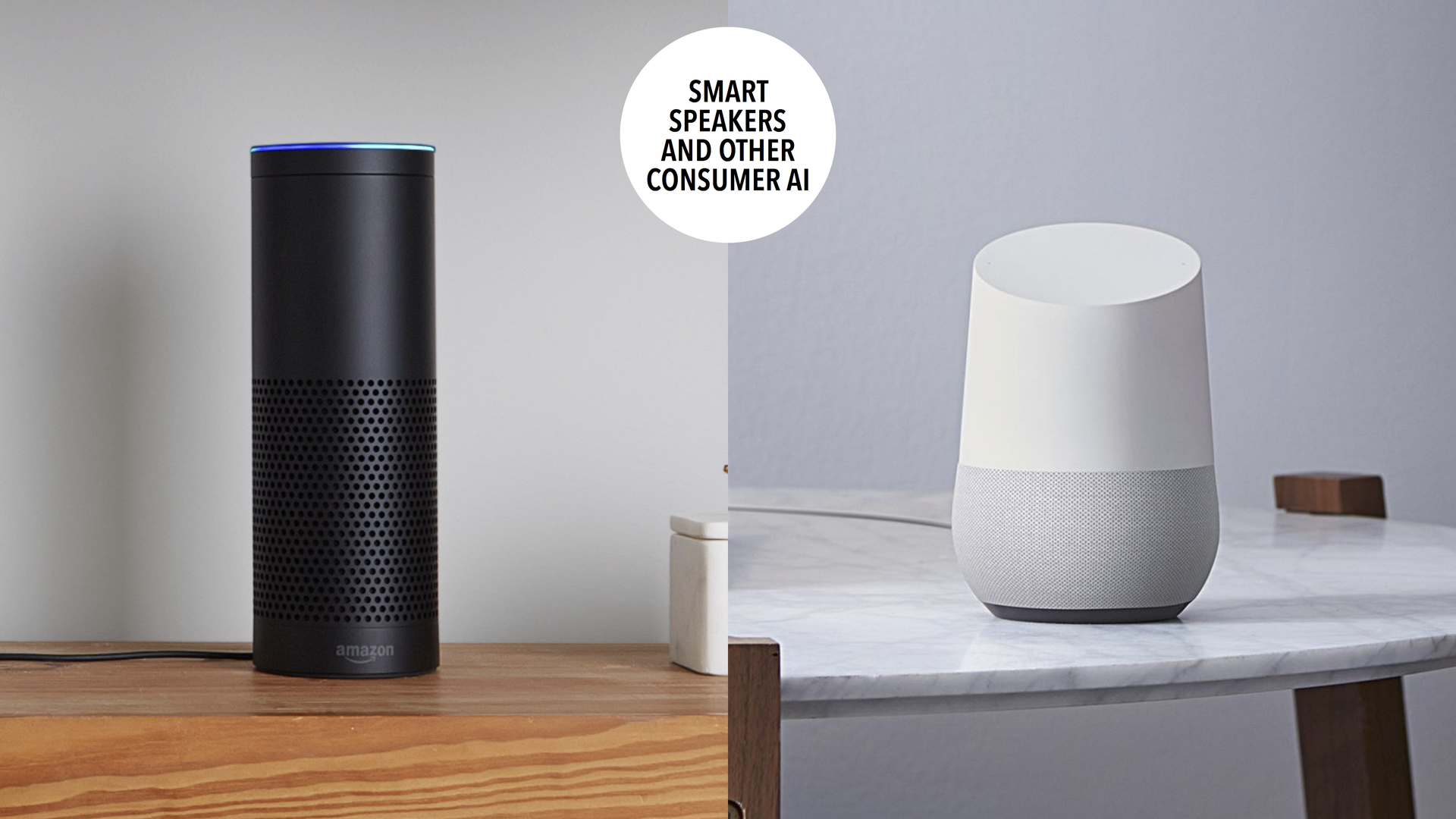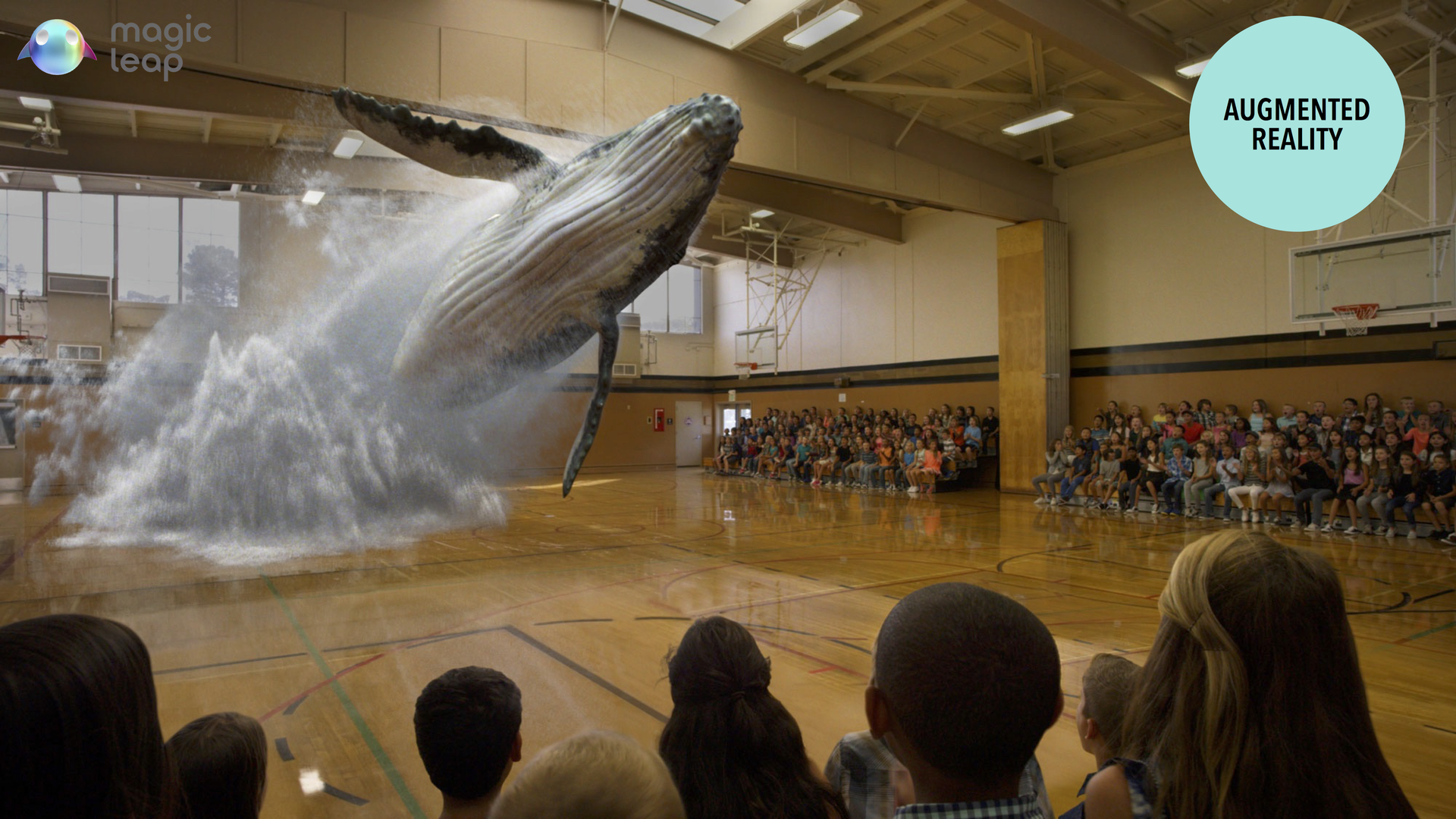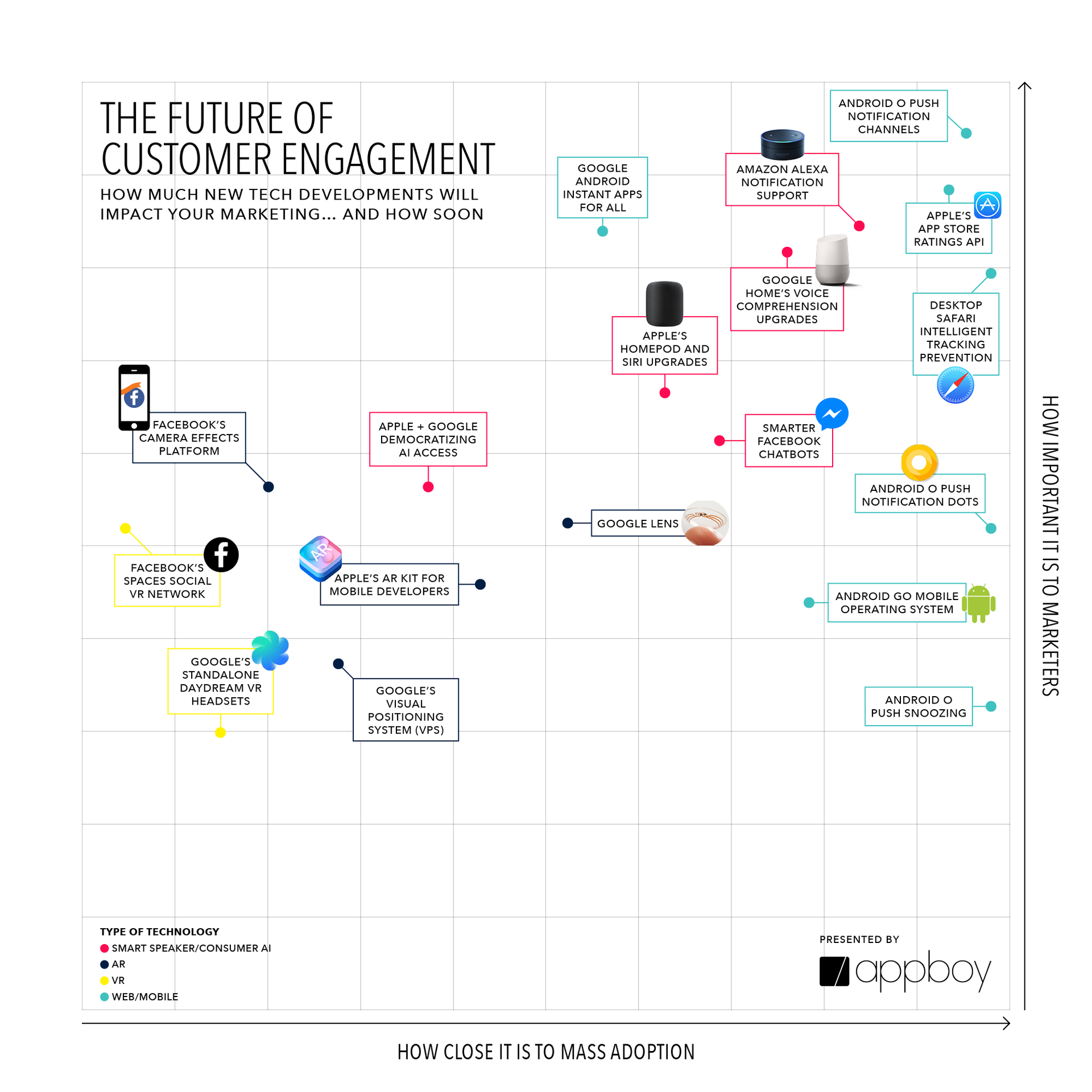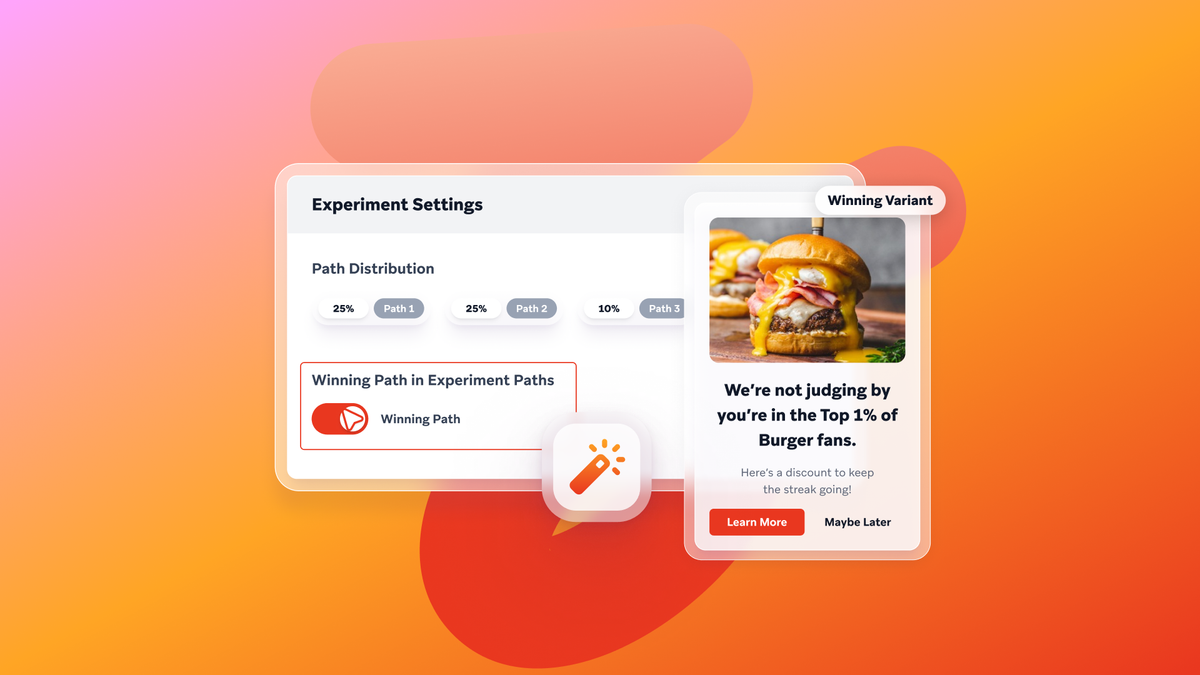Marketing’s Future is Coming Fast
Published on July 10, 2017/Last edited on July 10, 2017/9 min read


Todd Grennan
Content Production Principal, Content Marketing at BrazeIt’s been just over ten years since the introduction of the iPhone, and all of the predictions about how mobile was going to take over the world have pretty much come true.
Right now, people are spending nearly 70% of their time online using smartphones and tablets, up from basically nothing a decade ago. Desktop usage has held on, too: declining 8% over the past four years, but still constituting more than 30% of digital usage. But while mobile has become the central way that people go online, there are signs that its meteoric growth may be starting to level off. Between 2014 and 2016, year over year growth in smartphone shipments fell from 28% to 3%—that’s a decline of 89%.
With those platforms maturing, more and more brands are on the lookout for new technologies that can help them drive growth and engage more effectively with their customers. And while there’s no shortage of emerging technologies, it’s just not feasible for companies to take full advantage of every new platform that comes down the pike. To help marketers stay on top of where the digital landscape is headed, I sat down with Kevin Wang, Appboy’s VP of product, for a Technology Briefing webinar focused on this year’s major tech announcements and what they mean for the future of customer engagement. Let’s dig into the main findings.
Why this spring’s big tech events matter
When you’re looking to assess which emerging technologies are gaining steam and which starting to fizzle out, it’s best to pay close attention to what’s announced at spring conferences hosted annually by the biggest names in tech: Facebook’s F8, Google’s Google I/O, and Apple’s WWDC.
Appboy Spring 2017 Tech Briefing from Appboy
“At these big spring events,” Kevin said, “those tech giants reveal their big bets and the major technology initiatives that they’re putting their focus on. In past years, that’s been everything from push notification support for mobile devices to OTT messaging chatbots. And while not every announcement ends up being transformative, the tech that these companies choose to highlight is a key window into where they’re investing their money and resources for the future.”
This year, those big bets came in four main areas:
1. Smart speakers and other consumer-focused AI technologies

The smart speaker market has heated up significantly over the past year. Amazon first released its Echo smart speaker back in 2014, but it’s experienced a device adoption spike recently, with sales increasing 9x year over year during the 2016 holiday season. And at last year’s Google I/O conference, Google announced its own smart speaker (the Google Home), establishing this technology as a major focus for multiple tech giants.
Building on that momentum, we saw a lot of significant announcements this spring related to consumer-facing AI, including:
- Apple beefs up Siri’s AI capabilities and announces HomePod smart speaker: By improving Siri’s natural language processing and machine learning functionality and launching a new smart speaker, Apple signaled just how seriously it’s taking this space. Considering Apple’s track record for staying ahead of the curve, it’s safe to say that their investment increases the likelihood of speakers like these emerging as a major customer engagement channel in the near future.
- Google Assistant adds new functionality and limited notifications: Google Home is dipping its toes into the notification space with limited messaging from Google products, but the big news is the device’s new ability to tell different members of a household apart by voice. This new capability makes it possible to serve up personalized experiences in a way that neither of its two big competitors can currently match.
- Amazon announces support for third-party notifications on Echo devices: The move will make it is possible for outside brands to directly engage customers using Amazon’s Alexa digital assistant, opening up a world of engagement opportunities for companies where home is a major focus.
- Facebook invests in smarter chatbots: In addition to launching a new “Discover” tab designed to help users explore their chatbot options on the Messenger platform, Facebook also announced a significant breakthrough in the complexity of AI-powered chatbots. At this level of advancement, the update has the potential to transform how people interact with bots on the platform.
- Apple and Google expand AI access to outside brands: Apple announced that it will be opening up a machine learning API to help developers take advantage of AI within their iOS mobile experiences. In a similar move, Google said it would bring cloud-based AI systems—featuring pre-trained AI models—to the Google Cloud, potentially democratizing the use of machine learning and other forms of AI.
2. Augmented Reality (AR)

The augmented reality space has been defined by years of buzz and hype, particularly in connection to highly secretive technologies like Magic Leap, and one clear-cut success story: Snapchat’s facial filters. That all changed last summer, when Pokémon Go’s AR-powered mobile app burst onto the scene, introducing tens of millions of people to augmented reality and demonstrating that consumers will embrace this technology under the right circumstances.
That’s led Google and other tech giants to redouble their AR efforts and announce a number of significant initiatives in the space, including:
- Google brings AR into everyday life: Building off its pioneering Project Tango, Google announced a new AR-powered visual positioning system (VPS) designed to help map museums, retail stores, and other interior spaces, as well as Google Lens, which blurs the line between AI and AR by making it possible to gather information, make plans, and carry out other actions just by pointing your phone’s camera at text or real-life objects.
- Facebook wants your smartphone camera to be the next big platform: The company announced an AR platform of its own—known as Camera Effects—that’s intended to support developers as they develop augmented reality effects within the Facebook ecosystem. This new platform will potentially support the creation of a new, visually-focused customer engagement platform that third-party brands can leverage.
- Apple pushes augmented reality for mobile apps: With ARkit, introduced as part of iOS 11, Apple is working to help third-party brands take advantage of the sensors built into iPhones and iPads to create immersive AR experiences for their existing mobile audiences.
3. Virtual Reality (VR)

Ever since Facebook bought virtual reality startup Oculus in 2014—or maybe even since the introduction of Virtual Boy back in the 90s—people have been fascinated by the potential of VR as a new customer engagement technology. But while many observers believed VR would become a breakout consumer technology over the past few years, that hasn’t come to pass; in fact, VR’s been significantly overshadowed by augmented reality in the aftermath of Pokémon Go’s rise.
But while VR hasn’t taken off the way some predicted, this spring saw a lot of investment and innovation in the space, including:
- Google plans to introduce standalone VR headsets: Building on last year’s announcement of its Daydream virtual reality standard for third-party headsets and Android devices, Google announced that it would collaborate with Lenovo and HTC to create standalone Daydream VR headsets, demonstrating the seriousness of their investment in the space and increasing the chances that this tech becomes a major platform for customer engagement in the coming years.
- Facebook to launch social VR platform: Spaces, the new platform, will let users interact with friends and connections from other Facebook platforms in virtual environments or recreated real-life locations, extending the social elements of Facebook, Messenger, and Instagram into an immersive, virtual world.
4. Expanded web and mobile functionality

Although emerging technologies like AR and VR got most of the attention at this year’s Google I/O, F8, and WWDC, there were still a lot of significant announcements in connection with the two biggest existing digital platforms: mobile apps and the web. Those announcements included:
- Google gives app users more control over push notifications: With Android O, Google is allowing users to opt out of specific types of push notifications—instead of having to opt out of all messages in this channel. They’re also making it possible to see whether you’ve missed messages from particular apps and to snooze notifications when they arrive at inconvenient times, giving users more control over the messaging experience.
- Apple takes aim at intrusive app rating requests: As part of its overhaul of the App Store for iOS 11, Apple introduced an App Store Ratings API, making it possible for customers to rate your app without leaving it. This supports a more seamless user experience; however, Apple also banned the use of custom app rating request prompts and limited the number of requests brands can make to just three per user per year.
- Google opens up Instant Apps to all Android apps: A year after introducing them, Google announced that it would allow all Android apps use its Android Instant Apps feature, allowing brands to preload parts of their app onto Google’s cloud. This will make it possible for people who don’t have a given app to find it via Google search and then seamlessly use the portion of the app they need; that turns mobile web search into a new acquisition tool, but also increases the risk that customers will use elements of your app opportunistically on the web, rather than downloading.
- Desktop Safari will limit ad retargeting: As part of Apple’s continued push for increased user privacy, the company will leverage machine learning to stop most websites from serving ads to desktop Safari users based on their previous browsing material. This will limit the effectiveness of ad retargeting and make web push a more important part of an effective web re-engagement strategy.
- Google bets big on emerging economies with Android Go: By launching Android Go, a customized version of Android built for regions where data access and cost are a major issue, Google is positioning its mobile OS as the default for up and coming economies, which are expected to see billions of new users come online in the next decade.
How brands can get ready

Given all these big developments, the big question is: how can you make sure that your brand is prepared to take full advantage of emerging technologies that could grow into new, dominant platforms in the coming years? The key to success is accepting that not every technology is going to be a good fit for your customer engagement efforts—and focusing your energy on finding places where your investments can move the needle for your customer engagement strategy.
For a lot of these emerging technologies, “it’s still early,” Kevin said. “But if your brand sees an opportunity to engage customers on these platforms, it’s worth investigating. Pay attention to what your competitors and other brands you respect are doing here, and make sure you’re not falling behind.”
To dig deeper into this spring’s big tech developments and get additional guidance on how to get ready, watch the Tech Briefing webinar on demand:
Releated Content
View the Blog
AI A/B testing: Smarter experiments for real-time marketing optimization
October 30, 2025
How AI capabilities in Braze scale growth for financial services
October 29, 2025
Braze named one of America’s Greenest Companies 2026 by Newsweek
